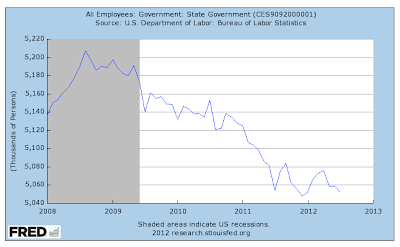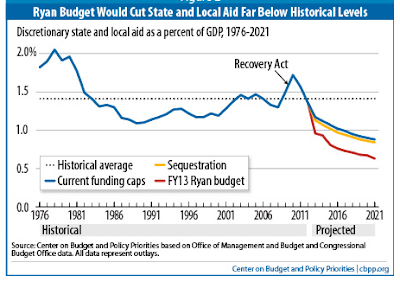This article was last updated on April 16, 2022
Canada: ![]() Oye! Times readers Get FREE $30 to spend on Amazon, Walmart…
Oye! Times readers Get FREE $30 to spend on Amazon, Walmart…
USA: ![]() Oye! Times readers Get FREE $30 to spend on Amazon, Walmart…
Oye! Times readers Get FREE $30 to spend on Amazon, Walmart…
A recent study by the Centre on Budget and Policy Priorities has taken a deeper look at the Paul Ryan Budget in a report entitled "Deficit-Reduction Package That Lacks Significant Revenues Would Shift Very Substantial Costs to States and Localities". In this report, CBPP looks at how a federal budget that cuts deficits without increasing revenue would make deep cuts in funds that support both state and local governments. It is these lower levels of government that provide us with the everyday services that taxpayers use; education, our roads and bridges and law enforcement among others services.
The fiscal picture of state governments has been grim since the Great Recession. In total, states have seen budget shortfalls of nearly $600 billion since fiscal 2009 and have been forced to make spending cuts in an attempt to bridge the funding gap. As shown on these two graphs, state and particularly local governments have shed a total of 697,000 jobs since their peaks in 2008:
By way of comparison, the Federal government has seen the number of its employees rise by 57,000 over the same time frame as shown here:
Odd, isn't it?
The Ryan budget would shift costs to the state and local level by doing the following:
1.) Cutting Medicaid Funding: The Ryan Budget would cut federal funding for the federal – state Medicaid program by 34 percent by 2022 and by larger amounts in later years compared to current law.
2.) Cutting non-Defense "Discretionary" Funding: The Ryan Budget would cut non-entitlement funding by 22 percent in 2014 and later years on top of Budget Control Act (BCA) spending caps. About one-third of discretionary funding is given to state and local governments to pay for services including education, law enforcement, disaster response, housing, public health care services and water treatment. On top of BCA cuts, the Ryan Budget cuts would amount to nearly $28 billion in 2014, adding up to $247 billion between 2013 and 2021.
The Ryan budget cuts would reduce discretionary state and local grants to an estimated 0.6 percent of GDP by 2021, less than half the average of the past 35 years as shown on this graph:
Lastly, here is a chart showing how the estimated cuts in discretionary grants under the Ryan Budget will impact the federal discretionary grants that each state receives between 2013 and 2021:
State and local governments would be forced to make up this cost shifting by either cutting services or raising revenue simply because politically paralyzed Washington would rather achieve a semblance of fiscal balance through spending cuts rather than revenue increases. Shifting the costs of services from one level of government to another is not saving anyone anything, however, it may make those in Congress feel positively heroic. Either way, taxpayers are going to pay. You'll just be making out your check to a different payee.
Click HERE to read more of Glen Asher's columns
You can publish this article on your website as long as you provide a link back to this page.






Be the first to comment